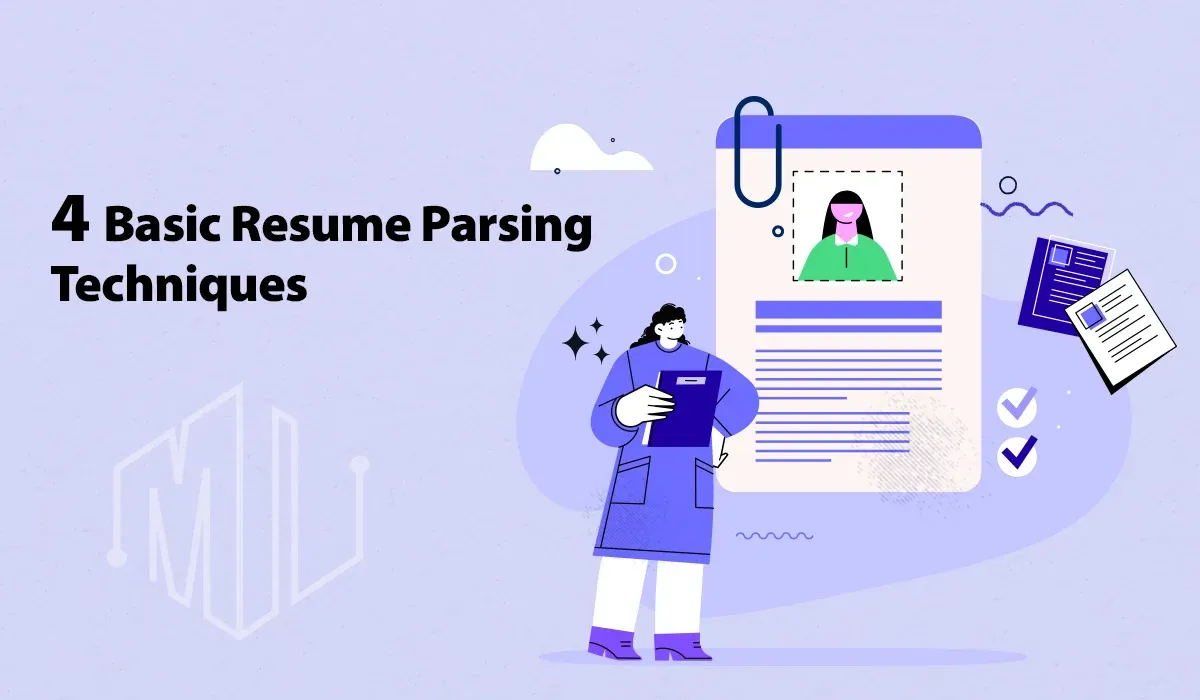4 Key Techniques for Effective Resume Parsing
In today's fast-paced recruiting environment, resume parsing has become an essential tool for HR professionals and recruiters. With a flood of applications for every open position, the need for efficient and accurate parsing methods to process resumes is more crucial than ever.

This blog post explores the 4 basic resume parsing techniques, each with its unique approach to simplifying the recruitment process.
✨ Unleash the Power of AI with MagicalAPI!
Whether you’re optimizing YouTube content, extracting LinkedIn data, or evaluating resumes, MagicalAPI is your one-stop solution! Discover the diverse range of AI services tailored to meet your every need. Dive in and elevate your digital experience today!

What Is Resume Parsing?
Resume parsing is a technology that automates the extraction of information from resumes. It scans and categorizes details like work experience, skills, and education into structured formats, usually for storage in databases or applicant tracking systems.
This automation streamlines the recruitment process, allowing recruiters to quickly search, filter, and evaluate candidates based on specific criteria, saving time and improving efficiency.
Resume parsing techniques use various methods to extract and categorize information from resumes efficiently.
These methods may include keyword identification, syntactical analysis, pattern recognition, and machine learning algorithms. The goal is to automate the extraction process, making it easier for recruiters and hiring managers to review candidate qualifications and make informed decisions.
let's explore 4 techniques of resume parsing:
1. Keyword-Based Parsers
The most rudimentary of all resume parsing techniques, keyword-based parsers, function by identifying specific words, phrases, and patterns within the resume text.
For instance, they may look for a sequence of four numbers to denote a year, but this approach has its limitations. It often fails to contextualize the data, mistaking a year of birth for a year of employment, or interpreting a term like ‘marketing’ in multiple, sometimes incorrect ways.
Despite its simplicity, keyword-based parsing is prone to errors, with an accuracy rate of around 70%.
2. Grammar-Based Parsers
A step up from keyword-based parsers, grammar-based parsers utilize a set of grammatical rules to interpret the information on resumes.
These parsers are more adept at understanding the various contexts of a word and can combine phrases and words to discern the meaning of each sentence. Though they require significant manual input during the setup, a well-coded grammar-based parser can analyze a resume effectively, boasting an accuracy rate of around 90%.
3. Statistical-Based Parsers
One of the resume parsing techniques is Statistical-Based Parsers. They apply numerical models to text to determine the context in which a word or phrase is used. They can differentiate whether a term like ‘coordination’ is a skill or part of a job description.
For these parsers to achieve accuracy, they must process a large volume of resumes to understand the information that needs to be extracted. Statistical parsers offer a balance between the low accuracy of keyword parsers and the higher accuracy of grammatical parsers.
4. AI-Based Parsers
At the forefront of resume parsing techniques are AI-based parsers. Leveraging advancements in artificial intelligence and machine learning, these parsers continuously improve as they process more data.
AI-based parsers excel in understanding the nuances of language, often surpassing human capabilities. They can interpret complex information layers in resumes, recognize spatial cues, and provide highly accurate parsing.
Modern AI parsers can understand language nuances and context better than previous methods, marking a significant breakthrough in resume parsing technology.
Why You Only Need AI Parsing
AI parsing technologies have revolutionized resume parsing by offering human-level understanding and versatility.
For instance, one of the best resume parsers uses AI to surpass traditional keyword, grammar, and statistical methods.
The AI models are tested against benchmarks to ensure superior language comprehension, outperforming human understanding in some aspects.
This capability allows AI parsers to understand multiple layers of information in a resume, picking up on spatial cues and context that traditional methods might miss.
The Benefits of Resume Parsing
Resume parsing offers several advantages to organizations. It saves time by efficiently sorting through resumes, keeps accurate records of applicants, saves resources, and importantly, helps eliminate biases in the recruitment process. By focusing on keywords and qualifications, resume parsing ensures that all candidates reaching the recruiter meet the basic job requirements, thereby streamlining the hiring process.
read more: Resume Parser vs. Manual Resume Screening: Which is better for your business?
How Does Resume Parsing Work?
Understanding the mechanics behind resume parsing is crucial. The process typically involves three steps:
Conversion:
- The parser identifies keywords and converts unstructured data into a structured format.
- Separation: It then segregates the information into relevant fields, such as work experience, skills, and education.
Structuring Data:
- Finally, the parser organizes the data into an easy-to-review format, providing a comprehensive overview of each candidate's profile.
Who Should Use Resume Parsing?
Resume parsing is beneficial for various roles within an organization:
- Recruiters benefit from quicker screening of applications.
- Hiring managers can further narrow down candidate selections based on specific criteria.
- HR departments, regardless of size, can ensure a consistent and efficient hiring process.
Tips for Effective Resume Parsing
To maximize the benefits of resume parsing, consider the following tips:
- Evaluate different resume parsing software options, considering their parsing capabilities.
- Don't rely solely on the software; periodically review its performance to ensure it meets your organization's needs.
- Make job postings specific to improve the accuracy of parsed data.
- Be cautious of keyword-heavy resumes that might not reflect the candidate's actual experience or qualifications.

Magical API Resume Parser Service
To further streamline your recruitment process, we are proud to introduce our Resume Parser service. Utilizing the latest advancements in AI and machine learning, our service offers a highly accurate and efficient solution for parsing resumes. Tailored to meet the demands of modern HR departments, our Resume Parser service simplifies the hiring process, allowing you to focus on selecting the best candidates.
Conclusion
Resume parsing techniques have transformed the recruitment process, offering efficient, accurate, and unbiased methods to process large volumes of applications. From the basic keyword-based approach to the advanced AI-driven methods, these resume parsing techniques cater to various needs and accuracy requirements in modern HR workflows.
FAQ
What is resume parsing?
Resume parsing is the automated process of extracting key information from resumes into a structured format. This technology enables recruiters to quickly sift through large volumes of resumes, identifying relevant candidate information without manually reading each one.
How does resume parsing benefit the hiring process?
Resume parsing significantly speeds up the hiring process by automating the screening of resumes. It helps in filtering out unqualified candidates, identifying those who match the job criteria more efficiently, and reducing the risk of bias in the initial screening stages.
What are some challenges associated with resume parsing?
Challenges include the potential for overlooking qualified candidates who do not use specific keywords, issues with keyword stuffing by candidates, and difficulties in interpreting ambiguous terms.

Join to our community
By joining our Discord server, get assistance, and troubleshoot any challenges you may encounter while using our services.
Join us on Discord




